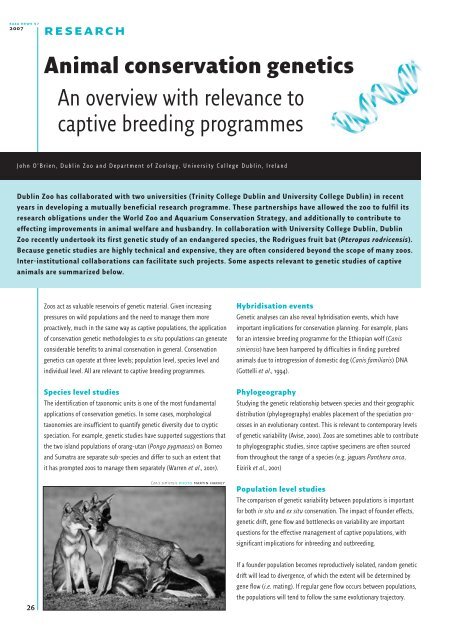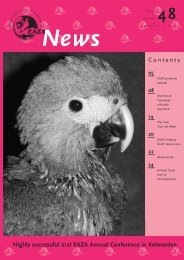EAZA News 57-12 - European Association of Zoos and Aquaria
EAZA News 57-12 - European Association of Zoos and Aquaria
EAZA News 57-12 - European Association of Zoos and Aquaria
You also want an ePaper? Increase the reach of your titles
YUMPU automatically turns print PDFs into web optimized ePapers that Google loves.
eaza news <strong>57</strong><br />
2007<br />
26<br />
research<br />
Animal conservation genetics<br />
An overview with relevance to<br />
captive breeding programmes<br />
John O’Brien, Dublin Zoo <strong>and</strong> Department <strong>of</strong> Zoology, University College Dublin, Irel<strong>and</strong><br />
Dublin Zoo has collaborated with two universities (Trinity College Dublin <strong>and</strong> University College Dublin) in recent<br />
years in developing a mutually beneficial research programme. These partnerships have allowed the zoo to fulfil its<br />
research obligations under the World Zoo <strong>and</strong> Aquarium Conservation Strategy, <strong>and</strong> additionally to contribute to<br />
effecting improvements in animal welfare <strong>and</strong> husb<strong>and</strong>ry. In collaboration with University College Dublin, Dublin<br />
Zoo recently undertook its first genetic study <strong>of</strong> an endangered species, the Rodrigues fruit bat (Pteropus rodricensis).<br />
Because genetic studies are highly technical <strong>and</strong> expensive, they are <strong>of</strong>ten considered beyond the scope <strong>of</strong> many zoos.<br />
Inter-institutional collaborations can facilitate such projects. Some aspects relevant to genetic studies <strong>of</strong> captive<br />
animals are summarized below.<br />
<strong>Zoos</strong> act as valuable reservoirs <strong>of</strong> genetic material. Given increasing i<br />
pressures on wild populations <strong>and</strong> the need to manage them more<br />
proactively, much in the same way as captive populations, the application<br />
<strong>of</strong> conservation genetic methodologies to ex situ populations can generate<br />
considerable benefits to animal conservation in general. Conservation<br />
genetics can operate at three levels; population level, species level <strong>and</strong><br />
individual level. All are relevant to captive breeding programmes.<br />
Species level studies<br />
The identification <strong>of</strong> taxonomic units is one <strong>of</strong> the most fundamental<br />
applications <strong>of</strong> conservation genetics. In some cases, morphological<br />
taxonomies are insufficient to quantify genetic diversity due to cryptic<br />
speciation. For example, genetic studies have supported suggestions that<br />
the two isl<strong>and</strong> populations <strong>of</strong> orang-utan (Pongo pygmaeus) on Borneo<br />
<strong>and</strong> Sumatra are separate sub-species <strong>and</strong> differ to such an extent that<br />
it has prompted zoos to manage them separately (Warren et al., 2001).<br />
Canis simiensis photo martin harvey<br />
Hybridisation events<br />
Genetic analyses can also reveal hybridisation events, which have<br />
important implications for conservation planning. For example, plans<br />
for an intensive breeding programme for the Ethiopian wolf (Canis<br />
simiensis) have been hampered by difficulties in finding purebred<br />
animals due to introgression <strong>of</strong> domestic dog (Canis familiaris) DNA<br />
(Gottelli et al., 1994).<br />
Phylogeography<br />
Studying the genetic relationship between species <strong>and</strong> their geographic<br />
distribution (phylogeography) enables placement <strong>of</strong> the speciation processes<br />
in an evolutionary context. This is relevant to contemporary levels<br />
<strong>of</strong> genetic variability (Avise, 2000). <strong>Zoos</strong> are sometimes able to contribute<br />
to phylogeographic studies, since captive specimens are <strong>of</strong>ten sourced<br />
from throughout the range <strong>of</strong> a species (e.g. jaguars Panthera onca,<br />
Eizirik et al., 2001)<br />
Population level studies<br />
The comparison <strong>of</strong> genetic variability between populations is important<br />
for both in situ <strong>and</strong> ex situ conservation. The impact <strong>of</strong> founder effects,<br />
genetic drift, gene flow <strong>and</strong> bottlenecks on variability are important<br />
questions for the effective management <strong>of</strong> captive populations, with<br />
significant implications for inbreeding <strong>and</strong> outbreeding.<br />
If a founder population becomes reproductively isolated, r<strong>and</strong>om genetic<br />
drift will lead to divergence, <strong>of</strong> which the extent will be determined by<br />
gene flow (i.e. mating). If regular gene flow occurs between populations,<br />
the populations will tend to follow the same evolutionary trajectory.

















